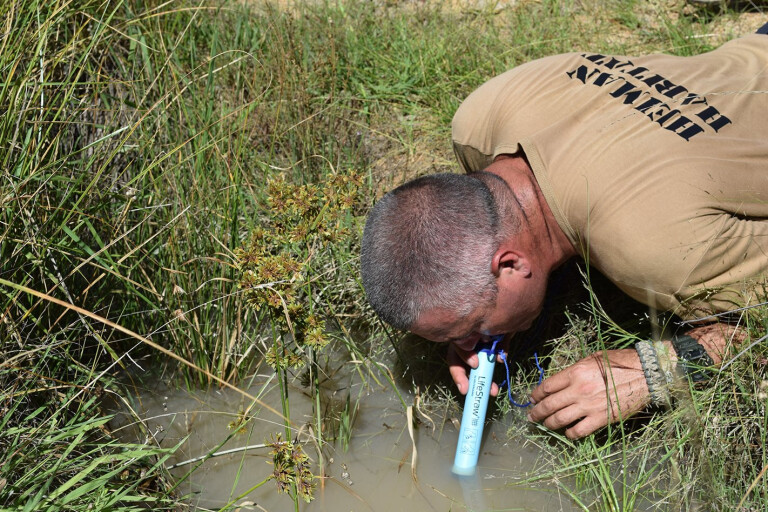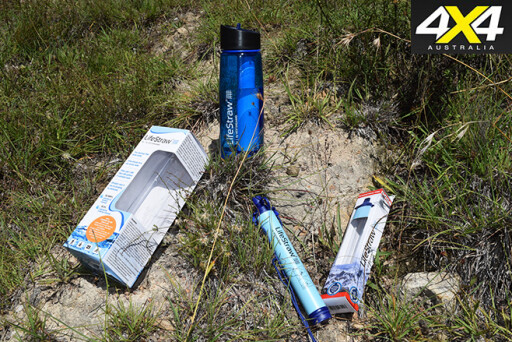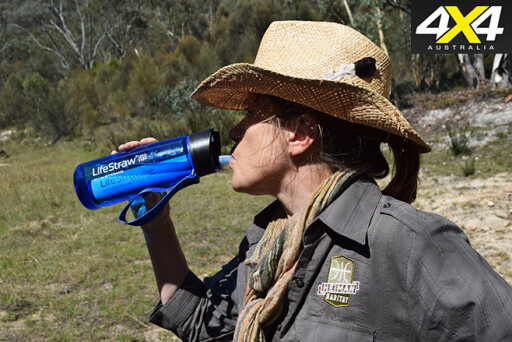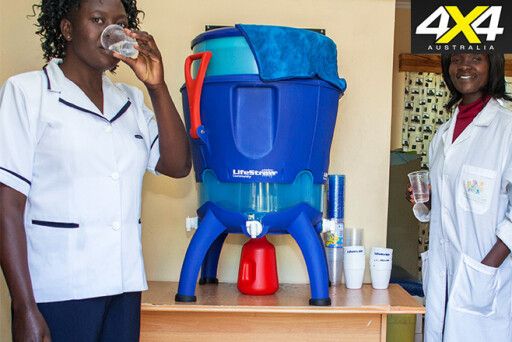
Whether heading bush on a major trip, or taking a quick weekend foray into the hinterland, we should always ensure there is plenty of water to drink and equipment to purify it when it’s not clean.
On long trips we’ll often have in-vehicle bladders, water tanks or water drums, though having good water receptacles doesn’t guarantee good water. The quality of our water will only be as good as the source from which we obtain it. So if we top-up from contaminated sources, or don’t keep our jerries clean, we risk becoming sick. Just remember, while the locals may drink water from the town’s water tower, the microflora in your gut may not be able to handle it.
On shorter trips, many of us might not bother to load up with water from home. After all, we’ll be home by Sunday lunch – won’t we? What happens if you get bogged somewhere remote, or something breaks? How would you stay hydrated until you’re recovered?
 The LifeStraw range provides a water purification solution for all sorts of scenarios. Originally designed for use in developing nations and in humanitarian crises, the products now also have a range of applications for the outdoor professional and recreationist.
The LifeStraw range provides a water purification solution for all sorts of scenarios. Originally designed for use in developing nations and in humanitarian crises, the products now also have a range of applications for the outdoor professional and recreationist.
The LifeStraw range is lightweight and ideal for hiking, camping, travel, emergencies and survival. It makes contaminated or suspect water safe to drink by removing 99.9 per cent of waterborne bacteria and protozoan parasites, including E. coli and salmonella. It will even reduce the amount of suspended particulate (dirt) by filtering out anything larger than 0.02 microns in size. The range is also BPA-free and recyclable.
LifeStraw has been winning awards since its first release in 2005. It was named the best invention of 2005 by TIME Magazine. In 2008, it won the Saatchi & Saatchi award for World Changing Ideas, and in 2014 LifeStraw Go won the prestigious ISPO award in the outdoor trekking and equipment category.
The Range
LifeStraw Personal is a straw that can be worn around the neck with a lanyard. At 216x32mm and weighing 56g, this unit can filter 1000 litres of water. If you’re on foot it can be used to suck water straight out of potholes, creeks and even hard to reach pockets, like hollows in trees. While it takes a bit of sucking to get the water through the straw (like sucking a thick shake through a straw), it is still a great piece of equipment. Keep one for emergencies, or to conveniently reduce the amount of water you need to carry when bushwalking.
 LifeStraw Go incorporates the LifeStraw technology into a durable and lightweight BPA-free water bottle with a flip-top bite valve. To use it, simply scoop water from a source, screw on the lid, and sip clean water through the mouthpiece. A drawback is that the straw sold in the Go is not the same as that in the LifeStraw Personal. So you can’t interchange the two.
LifeStraw Go incorporates the LifeStraw technology into a durable and lightweight BPA-free water bottle with a flip-top bite valve. To use it, simply scoop water from a source, screw on the lid, and sip clean water through the mouthpiece. A drawback is that the straw sold in the Go is not the same as that in the LifeStraw Personal. So you can’t interchange the two.
That’s a relatively minor design defect, though. With a 700ml capacity and the ability to fit in most cup holders, it is good to ‘Go’ at home, in the office, on the road, on a track, or on your bike. It makes us wonder why you’d want to head outdoors with a water bottle that wasn’t a Lifestraw Go.
LifeStraw Family 2.0 is the next generation of the high-volume unit. While you can still find the original Family 1.0 on shelves (and it’s still fit for purpose), the Family 2.0 is more effective and user-friendly. Filtering up to 30,000 litres of water, it’s designed to supply a family of five with clean drinking water for up to five years. It has a five-litre dirty-water compartment, and a built-in safe storage container with a tap and built-in backwash cleaning system. It has replacement filters for when the 30,000 litres are used and the filter eventually blocks (unfortunately the filters aren’t interchangeable with those in other Lifestraw products). With dimensions of 220x250x385mm, and weighing 2.4kg, this unit is built for bush shacks, fishing trips, touring rigs and campervans.
LifeStraw Home is a tabletop system (about the size of an office water dispenser) that’s built for home use, with the added benefit of removing viruses and chlorine by use of an activated charcoal filter. Suitable for homes connected to a dam or water tank, such as those you would find on rural properties, at club houses, or at pit stops along walking tracks.
 Depending on where you live, you may also want to consider a LifeStraw Home for your house or unit – did you know that some councils are still serviced by wooden pipes in the water system? Who knows if the trees in your backyard have tapped into the water mains? Surprisingly, for its size, this unit can only filter up to 4500 litres of water before needing replacement filters.
Depending on where you live, you may also want to consider a LifeStraw Home for your house or unit – did you know that some councils are still serviced by wooden pipes in the water system? Who knows if the trees in your backyard have tapped into the water mains? Surprisingly, for its size, this unit can only filter up to 4500 litres of water before needing replacement filters.
How does it work?
LifeStraw products are designed with a matrix of hollow fibres acting as individual ‘straws’. Water exits these fibres through microscopic holes in the side walls. These holes are small enough to trap bacteria, protozoa, and other harmful contaminants.
The products have no moving parts or batteries and they don’t use chemicals like chlorine or iodine. This is a bonus because water purification tablets that use these chemicals are not recommended to be used for extended periods (using them longer than three days can damage your kidneys).
What won’t it do? LifeStraw products can’t filter dissolved material such as salt, heavy metals, fuel and poisons. So they’re of limited use in a boat and marine environment where you should use a reverse osmosis pump instead.
Can you clean it? Sure can – by backwashing. This simply involves blowing out any debris directly after you’ve used it. For product longevity, we’d also recommend a regular wash in a glass of warm water for the LifeStraw Personal and the LifeStraw Go units. This will prolong the unit’s life and ensure that the straws don’t get clogged and become difficult to suck through. So soak the business end in warm water and suck and blow to clean the filter.
Don’t suck too hard if the unit is blocked, as you may suck clay deposits further inside. Other LifeStraw units have a backwash handle to manually pump clean the unit.
RATED
Available from: TJM and other stockists
RRP: From $30 to $380
We say: Innovative, ingenious, and lifesaving

COMMENTS